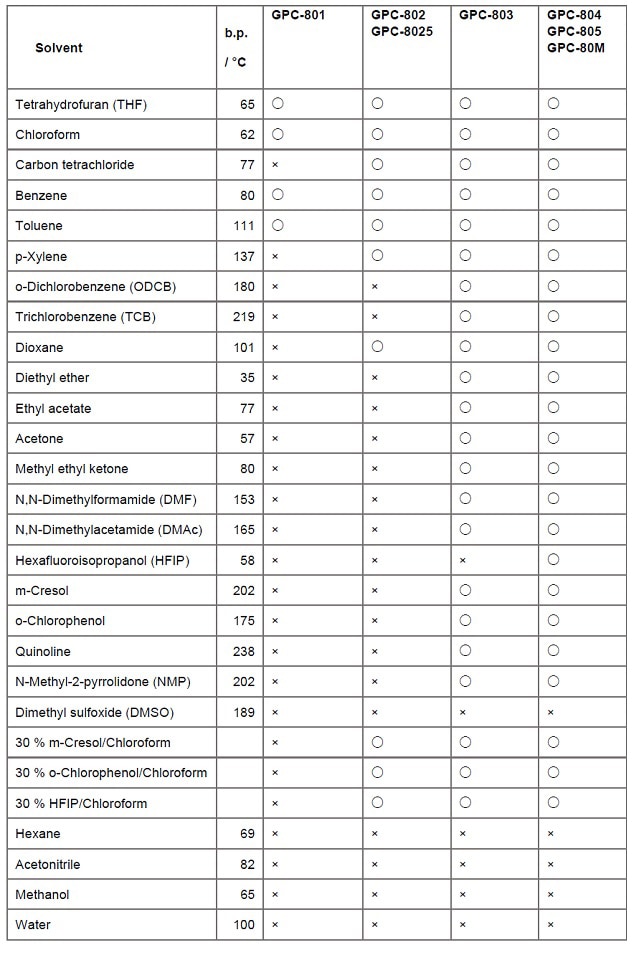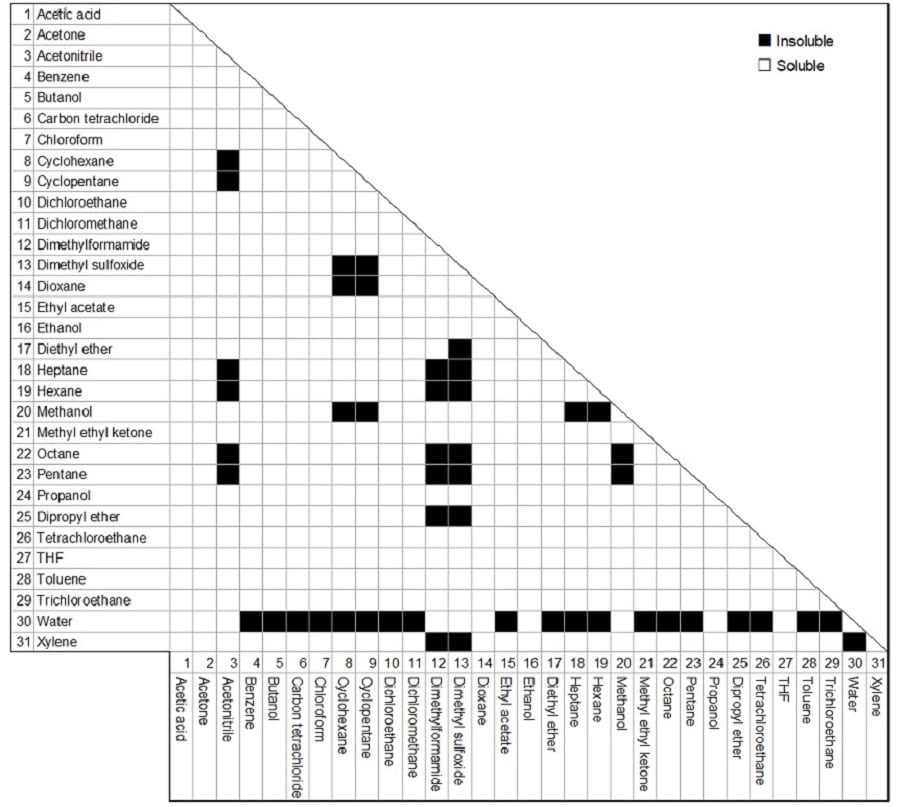The Nexera GPC System provides highly reliable and highly extensible performance in a wide variety of applications.
Shim-pack GPC Series - Features
HPLC Column
GPC Series Analysis Examples
Calibration Curves
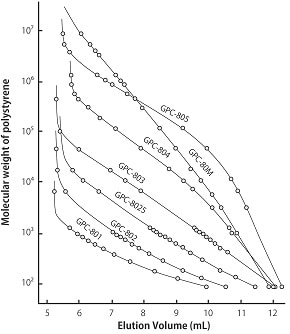 |
|
Analysis of Polystyrene Standard
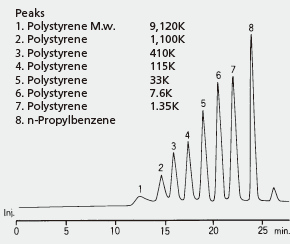 |
|
For more applications, please click here.
Determination of Tetrahydrofuran
| Column | Exclusion Limit (polystyrene) |
Dimensions (Length x I.D., mm) |
P/N |
|---|---|---|---|
| Shim-pack GPC-801 | 1.5 x 103 | 300 x 8.0 | 228-20803-91 |
| Shim-pack GPC-802 | 5 x 103 | 300 x 8.0 | 228-20804-91 |
| Shim-pack GPC-8025 | 2 x 104 | 300 x 8.0 | 228-20805-91 |
| Shim-pack GPC-803 | 7 x 104 | 300 x 8.0 | 228-20806-91 |
| Shim-pack GPC-804 | 4 x 105 | 300 x 8.0 | 228-20807-91 |
| Shim-pack GPC-805 | 4 x 106 | 300 x 8.0 | 228-20808-91 |
| Shim-pack GPC-806 | 4 x 107 | 300 x 8.0 | 228-20809-91 |
| Shim-pack GPC-80M (Mixed gel) | 2 x 107 | 300 x 8.0 | 228-20810-91 |
| Shim-pack GPC-800P | Guard Column | 10 x 4.6 | 228-20812-91 |
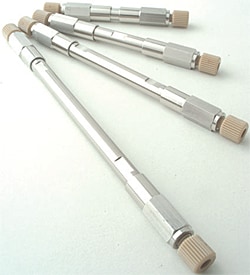
Mixed gel column : Shim-pack GPC-80M
Shim-pack GPC-80M is mixed gel columns capable of analyzing samples over a wide range of molecular weight distribution.
Shim-pack GPC-2000 Series Preparative Columns
Preparative columns for use with chloroform and tetrahydrofuran.
These columns have substantial sample processing power as well as separation power comparable to that of columns for analytical use.
Solvent Exchange for Shim-pack GPC Series Columns
The Shim-pack GPC series are columns used in size exclusion chromatography that separate based on the size of the sample, typically polymers with a wide range of molecular weight. A solvent that completely dissolves the target polymer is used for analysis, and the most common GPC solvents are chloroform, THF, and DMF.
This guide explains how to exchange the shipping solvent (contained in a new column) for the Shim-pack GPC series to a different solvent required for analysis.
Before using any column, be sure to check the instruction manual included with the product for care and usage guidelines.
Check points before exchanging the solvent
Solvent substitution for a column can degrade the column packing material and render it unusable if it is exchanged incorrectly. Be sure to check the following before exchanging the solvent of a column.
1) Compatible solvents for each column
2) Solvent miscibility if multiple exchange steps are required
3) Boiling point of solvent used during the exchange step(s)
4) Column specifications (Maximum allowed pressure, normal flow rate, column volume)
5) Upper limit of the pump pressure relative to the column maximum pressure
6) Solvent compatibility of the LC system components
1) Compatible solvents for each column
Refer to the table of compatible (available) solvents for each column (see: Available solvents on GPC series columns). Note that the available solvents may differ even in the same series of columns.
2) Solvent miscibility
Check the miscibility of the solvent to be substituted for the shipping solvent in the column (see: Miscibility of each solvent). In addition, check the solubility of any salt modifiers intended for use with the various solvents.
For example, THF, chloroform, DMF, and HFIP are miscible with each other. However, sodium trifluoroacetate dissolves in HFIP, but it is difficult to dissolve in THF. Therefore, sodium trifluoroacetate may precipitate when HFIP with sodium trifluoroacetate is combined with THF. It is very important to confirm the solubility of any salt that will be added to the solvent(s) used for exchange and analysis.
3) Boiling point of solvent
During solvent substitution, the column pressure can be lowered by heating the column, but if the column temperature is higher than the boiling point of the solvent used, bubbles may form and adversely affect the column. Refer to the boiling point of each available solvent in the table, and be sure to perform the solvent exchange at a temperature below the boiling point of all solvents used.
4) Column specifications
Refer to the following table and the column’s instruction manual to check the column specifications.
| Column | Normal flow rate (mL/min) |
Maximum flow rate (mL/min) | Maximum pressure per column (MPa) | Maximum temperature (℃) |
|---|---|---|---|---|
| GPC-800 series | 0.5 ~ 1.0 | 2.0 | 3.5 | 60 |
Calculate the volume of the column from the column inner diameter and length.

5) Setting upper limit of pump pressure
Set the upper pressure limit of the pump so that the maximum pressure of the column is not exceeded during solvent substitution.
The displayed pressure of the pump is the sum of the total system pressure and the column pressure. Because the system pressure and column pressure differ depending on the conditions, check the system pressure in advance under the same conditions as for solvent substitution (without the column connected,) and set the sum of the system pressure and the maximum pressure of the column to the upper limit of the pump pressure. If you connect multiple columns, add up the maximum pressures of each column. For example, if the system pressure without the column is 1.3 MPa and the column maximum pressure is 3.5 MPa, set the system maximum pressure to 4.8 MPa.
6) Solvent compatibility of the LC system components
Some materials used in the HPLC flow path have limited durability with certain organic solvents. Refer to the user manual of each module to confirm all solvent compatibility before solvent substitution.
Solvent substitution procedure
1) Heat the column while flowing the matching column-containing solvent at less than half the normal flow rate. (The set temperature for heating the column depends on the type of column and boiling point of the solvent used.
2) If the existing solvent is completely miscible with the solvent to be substituted
When the column temperature rises, flow the intermediate solvent in an amount 3 ~ 5 times the column volume. (Intermediate solvent is a 1:1 mixture of the solvent contained in the column and the solvent to be substituted.) Then, change to 100% of the solvent to be substituted, and flow 3 ~ 5 times the volume of the column.
Example Replace Shim-pack GPC-803 (shipping solvent THF, 15mL column volume) with chloroform
- Flow 45 ~ 75 mL of a 1:1 mixture of THF and chloroform (the intermediate solvent), and then flow 45 ~ 75 mL of chloroform
3) Change the flow rate and temperature to the analysis conditions and start the analysis when the baseline and pressure are stable.
Caution:
Do not exchange the solvent frequently since it can quickly degrade the column and reduce its lifetime. If you are using several methods which would require frequent solvent exchange, we recommend that you use a dedicated column for each solvent.




